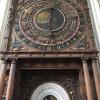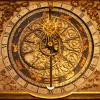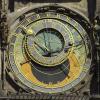Clone of San Zeno Wheel (Verona, c. 1450)
Commentary
Date: c. 1455
Provenance: Basilica of San Zeno, Verona
Image 1: 3D model of the Wheel, photography by Sarah Griffin, rendered by Jamie Cameron
Image 2: Front of Wheel
Image 3: Back of Wheel
Image 4: Cloisters of the Basilica of San Zeno, Verona
Images 5-6: Details of the Wheel
The 'San Zeno Wheel' consists of three movable disks that turn on a central axis, a device also known as a 'volvelle'. The disks are made of pine covered in vellum, giving the impression of a huge manuscript sheet. The diameter of the main disk is almost 1.3 metres, indicating that it was designed to be viewed by more than one person at a time. The base disk is essentially a calendar with columns which give the duration of daylight and darkness for each day of the year. This meant it could be used to look up the saints' days and to predict the time for sunrise and sunset on any given day. The two disks on top make a lunar volvelle which, when turned, show the changing phases of the moon. The lunar calendar was vital as it was necessary for the calculation of the most important feast days, most of all Easter, which moved each year. The Wheel would have therefore been used by the Benedictine monks at the basilica to structure their daily and annual routines.
The Wheel was originally made for the Basilica of San Zeno in Verona. The earliest published account of the Wheel, by a local antiquarian, Giovanni Battista Giuseppe Biancolini, is found in his Dei vescovi e governatori di Verona (1757), which records it as hanging on the inside wall of the cloisters by the loggia (see image 4 above). The entries in the calendar, which include saints of particular interest to the Basilica of San Zeno, show that the Wheel was almost certainly made to be displayed there.
It is an exceptional fifteenth-century horological device, the only one of its type to have survived. Yet certain features of the Wheel correspond to contemporary manuscript volvelles and to the liturgical calendars of larger horological devices. The Wheel is an invaluable testament to the original appearance of the earliest astronomical clocks, such as the calendar of the astronomical clock of St Mary's Church in Gdańsk below.
Gdańsk calendar.JPG
Calendar of the astronomical clock of St Mary's Church in Gdańsk, constructed between 1464-70 by Hans Düringer
Select Bibliography
G. Biancolini, Dei vescovi e governatori di Verona (Verona, 1757) [Available online through Archive.org], pp. 21-22.
S. M. Griffin: 'Synchronising the Hours: A fifteenth-century wooden volvelle from the Basilica of San Zeno, Verona,' Journal of the Warburg and Courtauld Institutes, LXXXI (2018), pp. 31-67.



